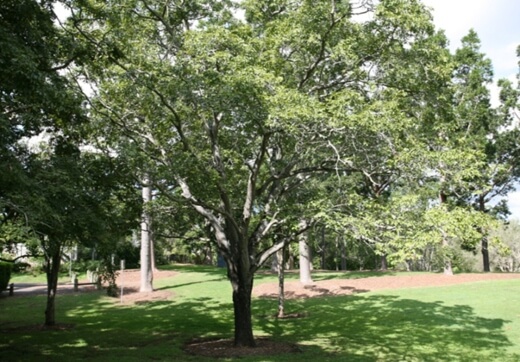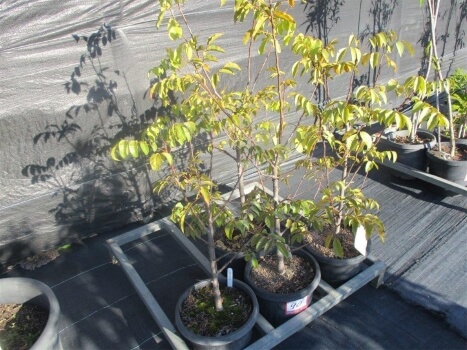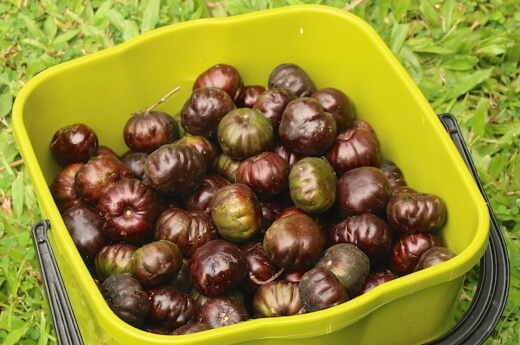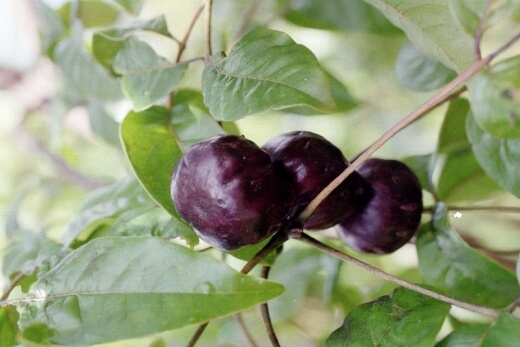We are so spoiled in Australia with great native plants and trees that provide divine bush tucker. Burdekin plum is one of these beauties that feels like the kind of tree that brings people together and makes a garden just that more beautiful.
In our how to grow and care guide, we’ll officially introduce you to the Burdekin plum, look at how to propagate it, how to care for your tree, some bush tucker information, pests and diseases to look out for, and end off with some frequently asked questions.
More...

Source: Sherwood Arboretum
Family: | Anacardiaceae |
|---|---|
Genus: | Pleiogynium |
Species: | P. timoriense |
Common Names: | Burdekin plum, Tulip plum |
Location: | Outdoor |
Type: | Tree |
Growth: | Up to 12 metres tall, Up to 9 metres wide |
Sun requirements: | Full sun |
Foliage Colour: | Dark green |
Flower Colour: | Yellow green |
Flowering: | January to March |
Fruit: | Large, black and round, similar to plums |
Maintenance level: | Average |
Poisonous for pets: | No |
Introducing Burdekin Plum Tree

Source: Australian Native Plants
Burdekin plum is native to Australia and is a fruit producing tree that is in fact a rainforest species. You might know it more commonly as the Tulip Plum. This is a great choice for the garden if you’re looking for a tree that will be hardy and handle drought well. The leaves are a dark green colour and the trunk of the tree is a dark grey.
The fruit of the Burdekin plum are quite large, are black and round with a big stone – hence the reference to plums in the name. There is a purple and a white variety and the tastes differ between the two.
The purple ones are tart, and the white variety is less acidic. You can eat the fruit raw if you wish when it’s ripe, but it’s also popular to make jams and wine. Pleiogynium timoriense flowers between the months of January and March. You’ll see small flowers that are a green yellow colour, and the fruit follows after.
You can harvest the fruit when you first notice them ripening but you’ll have to wait until they are fully ripe before you can eat them. The Aborigines used to bury the fruit underground and this helped to ripen the fruit.
How to Grow Burdekin Plum Tree
When planning where to plant your Burdekin plum, you’ll need to find somewhere that has full sun and has a loamy and well-draining soil. This will give you the best fruit and flower production. When the months are hot, your tree will need enough water and adding mulch will also help protect moisture levels.
Tulip Plum can handle some drought and frost. You can plant Pleiogynium timoriense in pots if you wish and it’s even been grown as a bonsai. The tree is great for providing shade and is loved by wildlife.
You could even use the tree to create a garden screen. In the garden, the Tulip Plum will usually grow to a maximum of 12 metres in height but in nature it has been known to reach up to 20 metres.
Propagating Burdekin Plum

Source: Grays
You are able to propagate your own Burdekin plum using the seed from the fruit. Once you’ve removed the seed from the fruit, wash it off in slightly warm water and make sure you get rid of any remaining pulp.
We also recommend cooling the seed down to between 1 and 5°C which helps the germination process. Germination takes about 12 weeks. You can wrap the seed in a moist paper towel, pop it into a plastic bag and then leave it in the fridge.


Get Your Free Guide:
Master Growing Australian Natives eBook
A Must Have Complete Guide for Every Australian Garden
Get Your Free Guide:
Master Growing Australian Natives eBook
A Must Have Complete Guide for Every Australian Garden
You would then leave it for about 8 weeks to prepare it, and keep an eye for any signs of sprouting. When sprouting has happened, you can then put the seed into a container with some well-draining soil.
We recommend a combination of vermiculite and potting soil and plant the seed to a depth of about 5 centimetres. Your container will need to be placed somewhere that is cool and with bright light.
Make sure the planting mixture stays moist. When the frost season has passed and temperatures are comfortable, you can then choose a spot in the garden for your tree.
Make sure it will get at least 6 hours of direct sunlight and be sure to add compost to the soil. Water the planting site and maintain moisture levels. Adding mulch or a compost will help to lock in moisture.
How to Care for Burdekin Plum
- Sunlight - Burdekin plum needs full sun to produce long periods of fruit and flowers.
- Soil - You need to have a soil with good drainage and the Tulip Plum needs to have a neutral pH soil.
- Watering Needs - This tree needs moderate watering, but in the initial growth phase, it should always be kept moist.
- Pruning - You can prune your tree once it has finished producing fruit. This helps to promote good growth and lots more fruit for the following season.
- Fertiliser - You can apply a native slow release fertiliser to your Burdekin plum in the spring.
Burdekin Plum Tree Bush Tucker

Source: Green Path
Burdekin plum does indeed look like the regular sort of plum that we know. The skin is a dark purple, and it’s smooth and shiny. It also has a big pip or seed in the middle.
There is also the white flesh variety which has a sweeter and milder flavour compared to the purple variety which is more tart. We don’t recommend eating Tulip Plum that is not yet ripe. It is way too acidic.
It’s worth noting that the fruit of the Burdekin plum doesn’t become ripe on the tree. Only once it has been harvested off the tree and had a chance to ripen, will you be able to enjoy the best flavour and texture.
If you want to encourage the fruit to ripen, you can bury it in sand, or otherwise keep it in a paper bag in a dark place for about a week.
Burdekin Plum Fruit Health Benefits
If you’re looking for health benefits, Burdekin plum is high in vitamin C, dietary fibre and minerals. It’s been proven that this fruit has 5 times the amount of antioxidants than blueberries. The ripe fruit is usually enjoyed sliced up in a fruit salad or can be eaten as is.
When cooked, the fruit makes a wonderful sauce to go with venison and kangaroo. There are no doubt family recipes for jams and jellies made from Burdekin plum too. The fruit is also great in a fruit pie. It really is so versatile. When storing your fruit, make sure to keep it somewhere cool and dry and not directly in the sun.
Historically, the Tulip Plum was much loved by the Aboriginal tribes. They called the fruit Gowan Gowan and Oolooboo. They were the ones who showed European settlers how to best ripen the fruit by burying it in sand.
Burdekin plum has been growing in Australia for 30 million years! We know this thanks to fossil evidence found in central Queensland which proves that the fruit originated from the ancient Gondwana.
Pests and Diseases that Affect Tulip Plum
Armillaria root rot
This fungal disease is sometimes called bootlace fungus or honey toadstool. Symptoms of the disease are yellow leaves, stunted growth, and dying back of the tree branches.
You’ll need to remove all infected parts of the tree, try and create root barriers to prevent spread, and expose the collar of the tree to air.
Stone fruit scab
This disease likes warm and wet areas and causes a type of scab on the fruit. It starts off as dark small spots and then becomes scabby later on. You’ll need to prune out affected parts of the tree and then treat with an organic fungicide.
Powdery mildew
This disease likes dry and warm conditions and looks like a white powder on various parts of the plant. You can use an organic fungicide for treatment and the most effective ones include sulphur, neem oil, or potassium bicarbonate. Baking soda is also effective.
Burdekin Plum Frequently Asked Questions

Source: Burringbar Rainforest Nursery
Where does the name Pleiogynium timoriense come from?
The name Pleiogynium comes from the Greek words pleion which means many, and gyné, which means woman. It is referring to the numerous female parts of the flower. Timoriense means occurring in Timor.
Where was the Burdekin plum first discovered?
The Burdekin plum was first discovered and collected at the Endeavour River in 1770.
How do the seeds operate and germinate in nature?
The seeds of the Burdekin plum are carried by fruit bats and wallabies. They can lie dormant for many years before germinating.
Is the Burdekin plum tree used for timber?
The timber of the Burdekin plum is considered some of the best by native wood-turners. The colour of the wood varies and can be anything from a pale to a dark reddish brown. It usually has streaks of darker coloured rings.
The timber copes well when colour stained or painted and is used to make cabinets, walking sticks and handles for umbrellas.
What other fruit is the Burdekin plum related to?
The Burdekin plum belongs to the Anacardiaceae family which includes mangoes, cashews, and pistachios.
What kind of wildlife eats the fruit of the Burdekin plum?
The fruits are much loved by cassowaries and great bowerbirds.
If you’re in need of more info and inspiration for your garden, sign up to our newsletter for plant profiles, reviews, and all things gardening related.
Wrapping Up Our Burdekin Plum Growing and Care Guide
A garden with a big fruiting tree that also provides plenty of shade, sounds like the ultimate dream. It creates visions of family picnics, children laughing and climbing branches, and lots of recipes tried out in the kitchen with the delicious fruit.
The Burdekin plum is the kind of tree that creates memories for generations to come. We’re giving it our green thumbs up!
Published on January 3, 2023 by Nathan Schwartz
Last Updated on January 19, 2025




